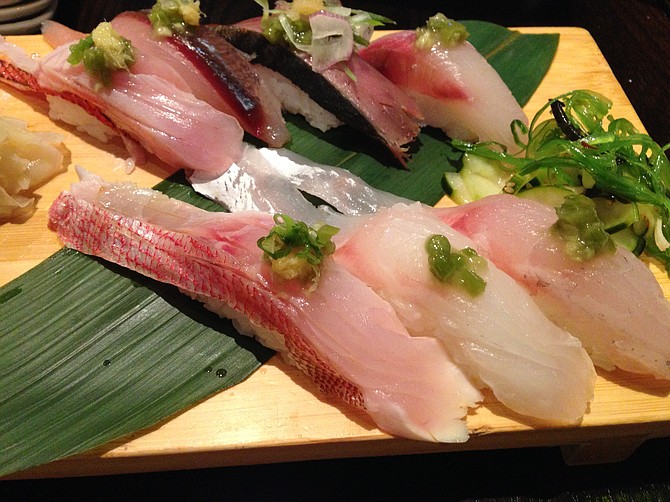 Facebook
Facebook
 X
X
 Instagram
Instagram
 TikTok
TikTok
 Youtube
Youtube

These days many restaurants opening in Liberty Station are an offshoot of a successful business from another part of town. Soda & Swine, Fig Tree Café, and the incoming Buona Forchetta have all taken advantage of cheap real estate by opening a larger second restaurant in a development full of large restaurants. Ikiru Japanese, on the other hand, remains small — a hole-in-the-wall sushi spot.
I’ve been wanting to try Ikiru since reading Ian Pike’s review a couple of years ago, if for no other reason than to try the genuine, fresh wasabi on the menu. Pike’s experience involved quality cuts of the usual sushi suspects: salmon, tuna, and the like. I thought I might give a few unusual fish a go, and Ikiru was happy to oblige.
I planned on omakase, allowing the chef to choose a fine assortment of fresh sushi or sashimi. But there on the specials menu was a $28 sushi combo featuring seven cuts of fish I’d never tried, many of them featuring names I’d never heard of — in Japanese or at an aquarium.
The kinmedai turned out to be golden eye snapper, and judging by its $13 à la carte price, it’s the greatest delicacy of the bunch. Chikame kintoki also goes by the name alfonsino, which sounds like something you’d pull out of the Mediterranean but comes from deep waters in the Pacific.
Flying fish I’d heard of, but I’ve never seen one on a menu as tobiuo. Likewise, I’ve encountered the fishy-tasting bonito flakes in sushi restaurants many times before but never the actual fish, here called katsuo. Tennen madai is Japanese for red seabream, and I needed Google to confirm that seabream is a type of fish. Hiramasa offered a glimpse of familiarity, being a kind of yellowtail. But this one’s also called amberjack, related to but different from hamachi.
Also part of the special was a crescent sweetlips called kosho-dai. But as this was in short supply, the chef had to swap it out for sea bass. I know I’d walked in ready to go chef’s choice, but I do wish he’d have given me some uni instead. I spotted that fresh-as-can-be sea urchin on a neighbor’s plate, and it made me nostalgic for something familiar.
The fish that I tried were mildly sweet and tender on the tooth. The exceptions were the bonita — which was lightly seared and had a smoky, gamy quality — and the alfonsino, which had what sushi eaters call a crunchy texture. The golden eye snapper did turn out to be the best, its lightness set off by the addition of Himalayan rock salt.
I enjoyed branching out, and I’d recommend Ikiru as a good place to expand one’s sushi palate. I did devour a spicy salmon hand roll before I left because I wanted a little comfort sushi for dessert. Also some mochi (rice cakes).


These days many restaurants opening in Liberty Station are an offshoot of a successful business from another part of town. Soda & Swine, Fig Tree Café, and the incoming Buona Forchetta have all taken advantage of cheap real estate by opening a larger second restaurant in a development full of large restaurants. Ikiru Japanese, on the other hand, remains small — a hole-in-the-wall sushi spot.
I’ve been wanting to try Ikiru since reading Ian Pike’s review a couple of years ago, if for no other reason than to try the genuine, fresh wasabi on the menu. Pike’s experience involved quality cuts of the usual sushi suspects: salmon, tuna, and the like. I thought I might give a few unusual fish a go, and Ikiru was happy to oblige.
I planned on omakase, allowing the chef to choose a fine assortment of fresh sushi or sashimi. But there on the specials menu was a $28 sushi combo featuring seven cuts of fish I’d never tried, many of them featuring names I’d never heard of — in Japanese or at an aquarium.
The kinmedai turned out to be golden eye snapper, and judging by its $13 à la carte price, it’s the greatest delicacy of the bunch. Chikame kintoki also goes by the name alfonsino, which sounds like something you’d pull out of the Mediterranean but comes from deep waters in the Pacific.
Flying fish I’d heard of, but I’ve never seen one on a menu as tobiuo. Likewise, I’ve encountered the fishy-tasting bonito flakes in sushi restaurants many times before but never the actual fish, here called katsuo. Tennen madai is Japanese for red seabream, and I needed Google to confirm that seabream is a type of fish. Hiramasa offered a glimpse of familiarity, being a kind of yellowtail. But this one’s also called amberjack, related to but different from hamachi.
Also part of the special was a crescent sweetlips called kosho-dai. But as this was in short supply, the chef had to swap it out for sea bass. I know I’d walked in ready to go chef’s choice, but I do wish he’d have given me some uni instead. I spotted that fresh-as-can-be sea urchin on a neighbor’s plate, and it made me nostalgic for something familiar.
The fish that I tried were mildly sweet and tender on the tooth. The exceptions were the bonita — which was lightly seared and had a smoky, gamy quality — and the alfonsino, which had what sushi eaters call a crunchy texture. The golden eye snapper did turn out to be the best, its lightness set off by the addition of Himalayan rock salt.
I enjoyed branching out, and I’d recommend Ikiru as a good place to expand one’s sushi palate. I did devour a spicy salmon hand roll before I left because I wanted a little comfort sushi for dessert. Also some mochi (rice cakes).
Comments